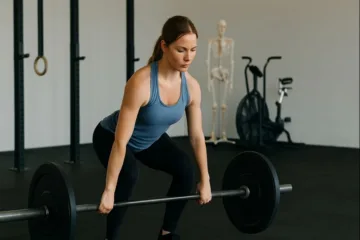What Is VO₂ Max? Why It’s One of the Strongest Predictors of Health
VO₂ max refers to your body’s maximum ability to take in, transport, and use oxygen during intense physical effort. In practical terms, it reflects how well your heart, lungs, blood vessels, and muscles work together when the system is under stress.
It is expressed as millilitres of oxygen per kilogram of body weight per minute (ml/kg/min) and is widely regarded as one of the most reliable indicators of cardiorespiratory fitness.
More importantly, VO₂ max is not just a performance metric. It is a powerful marker of health, resilience, and how well you are likely to age.
Why VO₂ Max Is About More Than Fitness
A higher VO₂ max does not simply mean you perform better during exercise. It means your body can meet physical demands with less strain.
That translates into:
- climbing stairs without excessive breathlessness
- carrying groceries or luggage with ease
- tolerating physical and mental stress more effectively
This functional reserve matters. Research consistently shows that higher VO₂ max values are associated with a lower risk of all-cause mortality, and particularly with a reduced risk of cardiovascular disease.
In other words, VO₂ max reflects how robust your system is, not just how athletic you appear.
How Is VO₂ Max Measured?
The gold standard for measuring VO₂ max is a laboratory-based maximal exercise test with respiratory gas analysis. This directly measures oxygen consumption under progressively increasing workload.
Today, many smartwatches and fitness trackers estimate VO₂ max using heart rate data, movement patterns, and recovery metrics. While these estimates are not as precise as laboratory testing, they are sufficiently accurate to track trends over time.
And that is where their real value lies. The trajectory matters more than the exact number.
What Does VO₂ Max Say About Ageing and Mortality?
VO₂ max naturally declines with age. This is largely due to:
- reduced cardiac efficiency
- declining pulmonary capacity
- loss of muscle mass (sarcopenia)
Because VO₂ max reflects the integration of these systems, a simple but uncomfortable truth applies:
The higher your VO₂ max, the better you tend to age.
Large-scale studies have shown that individuals with below-average VO₂ max values for their age and sex have a significantly higher risk of premature death. A 2018 study demonstrated that low cardiorespiratory fitness was associated with a twofold increase in all-cause mortality.
For context, smoking increases mortality risk by roughly 40%.
This does not make smoking acceptable. It highlights how profoundly damaging low cardiorespiratory fitness can be.
VO₂ Max as a Protective Buffer
One of the most important insights is this: VO₂ max is trainable.
Building a higher VO₂ max earlier in life creates a physiological buffer. Even as VO₂ max declines with age, individuals who start from a higher baseline tend to remain in the upper percentiles of their age group for longer.
Practically, this means:
- prolonged independence
- reduced frailty
- greater physical freedom later in life
Many daily activities feel trivial now. VO₂ max largely determines how long they remain that way.
How Can You Improve Your VO₂ Max?
VO₂ max only improves when the system is sufficiently challenged. Comfort does not produce adaptation.
1. High-Intensity Interval Training (HIIT)
Short bursts of near-maximal effort followed by recovery periods strongly stimulate cardiovascular adaptation.
Example:
30 seconds of high-intensity effort followed by 1–2 minutes of active recovery.
Repeat for 20–30 minutes.
(Jump rope is surprisingly effective.)
2. Moderate-Intensity Endurance Training
Sustained aerobic exercise improves oxygen delivery and utilisation over time.
Guideline:
30–60 minutes, 3–4 times per week
Approximately 60–75% of maximum heart rate
3. Variable Interval Training
Alternating pace within a single session trains both aerobic and anaerobic systems and reduces performance plateaus.
Examples include tempo changes during running, cycling, or rowing.
4. Strength Training (Often Overlooked)
Stronger muscles use oxygen more efficiently and slow age-related muscle loss.
Sarcopenia begins as early as the third decade of life, with muscle loss accelerating after age 50 if no intervention is applied.
Guideline:
2–3 sessions per week
Focus on compound movements such as squats, deadlifts, and lunges
Typical VO₂ Max Values
VO₂ max values vary by age and sex. As a general reference:
- Adult men: approximately 35–45 ml/kg/min
- Adult women: approximately 27–35 ml/kg/min
Values decline progressively with age. Context matters more than the absolute number. Your position relative to age-matched peers and your long-term trend are far more informative.
Frequently Asked Questions About VO₂ Max
What is a good VO₂ max for my age?
A “good” VO₂ max depends on age and sex. More important than the absolute value is how you compare to peers and whether your VO₂ max is stable, improving, or declining over time.
Is VO₂ max more important than muscle strength?
No. VO₂ max reflects cardiorespiratory capacity, while strength and muscle mass are essential for stability, mobility, and independence. Healthy ageing requires both.
Can VO₂ max still improve after 40 or 50?
Yes. Research shows VO₂ max remains trainable well into older age, provided the cardiovascular system is sufficiently stimulated.
Are smartwatch VO₂ max readings reliable?
Wearable estimates are useful for tracking trends, not for making medical decisions based on a single measurement.
Is a low VO₂ max dangerous?
A low VO₂ max relative to age is associated with increased risk of cardiovascular disease and premature mortality. It is a warning signal, not a diagnosis.
Final Thought
VO₂ max is not everything.
But it is one of the clearest indicators of how resilient your physiology actually is.
The encouraging part is that the human body remains adaptable at nearly any age.
The inconvenient part is that adaptation requires intentional stress.
You are free to ignore this information.
Your physiology will still respond to the choices you make.


